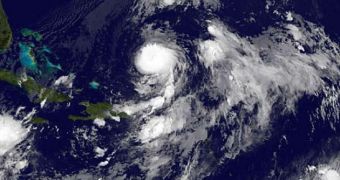The Miami, Florida-based National Hurricane Center (NHC) announced that subtropical storm Otto has been reclassified as Hurricane Otto, on October 8, at 11 am Eastern Time.
According to experts, the storm is expected to weaken today, October 9, but it will continue to blast winds at sustained speeds of up to 75 miles per hour (121 kilometers per hour).
Otto is the eight hurricane to develop during the 2010 Atlantic Hurricane Season. It is now located about 445 miles (716 kilometers) south of Bermuda.
The NHC reports that the cyclone is moving east-northeast, at a spear of 17 miles per hour (27 kph). It adds this atmospheric event is the fifteenth in the season to get a name.
In order for that to happen, cyclones need to develop into either tropical storms or hurricanes, Our Amazing Planet reports.
The subtropical depression that “haunted” the Caribbean since the beginning of the month finally decided to develop into a subtropical storm on October 6, and got the “official” name Otto.
According to conventions, only tropical storms and hurricanes get names. Otto is very different from tropical storms that came before it for several reasons.
First of all, it has broad wind patterns, and secondly, maximum sustained wind intensity areas are located a lot farther from the center of the system than they are in tropical cyclones.
This year was very rich in hurricanes and storms, with 17 named atmospheric events. Generally, the average is 11 tropical storms with six of them becoming hurricanes per season.
But this gave experts with NASA and other research initiatives the possibility to conduct research in the Gulf of Mexico using specialized airplanes.
The goal of the studies was to determine the factors that trigger the formation of dangerous hurricanes from average tropical storms.
Some of the atmospheric events simply fizzle out into heavy rain showers, whereas others go on to form tornadoes, and cause massive devastation.
NASA announced recently that its Genesis and Rapid Intensification Processes (GRIP) experiment had concluded successfully in the Gulf of Mexico. The space agency used three planes for the job.
Two manned aircraft, a DC-8 and a WB-57, and a remotely piloted UAV, the Global Hawk, were used to carry out the investigations.
“We're all very pleased we were able to get the Global Hawk over a hurricane. There was a question about that,” says Gerry Heymsfield, a mission scientist from the Goddard Space Flight Center.
“That's a major accomplishment both on the science side and the capability side. It really paves the way for future research,” he concludes.

 14 DAY TRIAL //
14 DAY TRIAL //